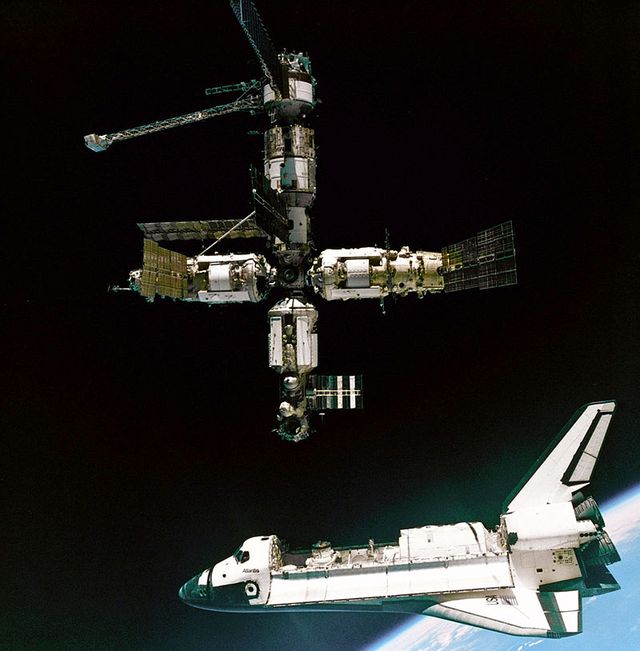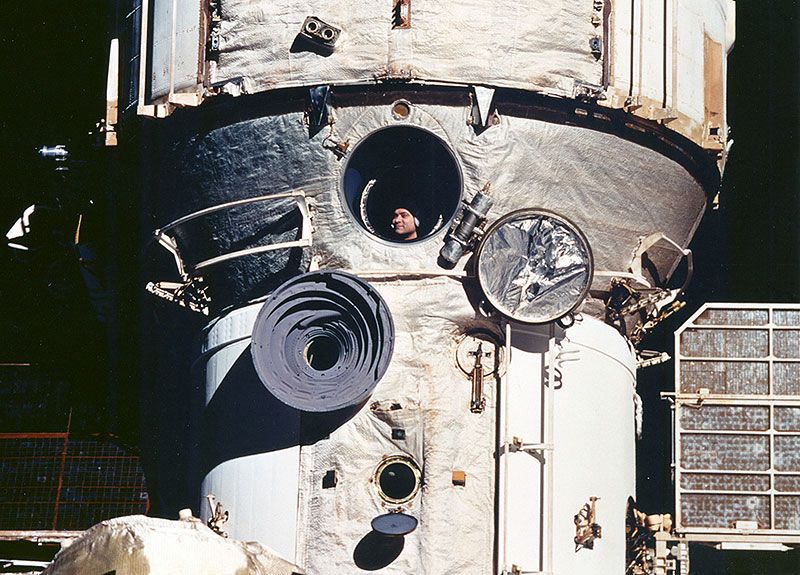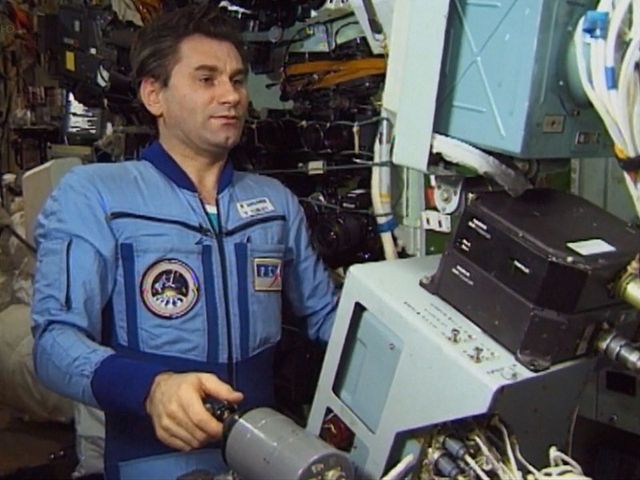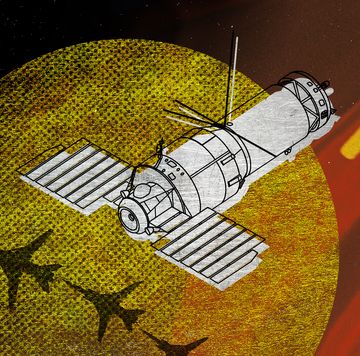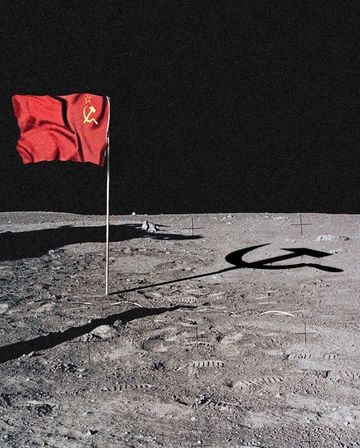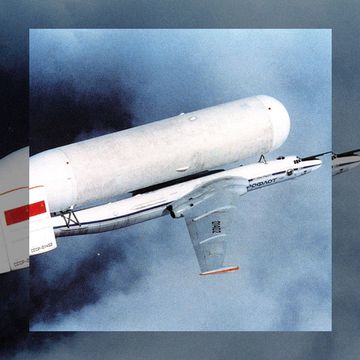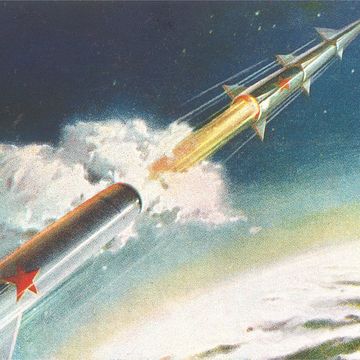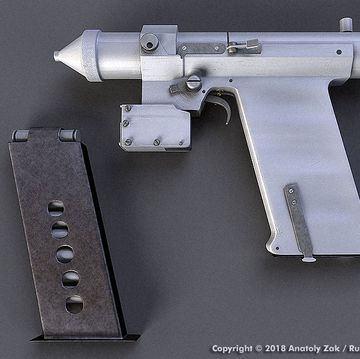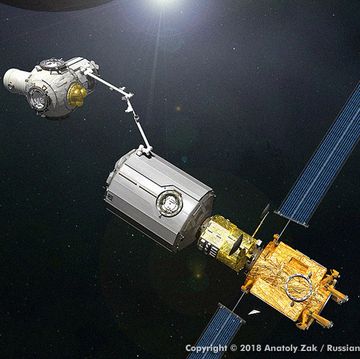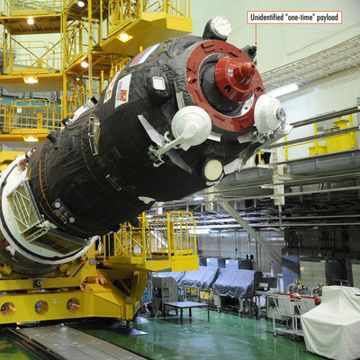Three decades ago this Saturday, the USSR orbited the first piece of Mir, which translates from Russian as "peace" or "world." The February 20, 1986, launch marked the beginning of an unprecedented 15-year mission, outlasting the USSR itself and achieving numerous breakthroughs in space.
Assembled of seven major components, Mir was the first truly modular space station and humanity's first almost permanently inhabited outpost off-planet. While it was born of the Cold War, Mir was eventually transformed into the largest arena for cooperation in space, paving the way to the International Space Station and the earliest space tourism ventures. But even as it was revolutionary, the space station was notorious. Mir also became the stage for some of the most dramatic and dangerous accidents in the history of human space flight.
A Tale of Two Space Stations
The first expedition to Mir in 1986 overlapped with the flight of the previous Soviet space station, Salyut-7. Before mothballing the old outpost in a graveyard orbit, the original Mir crew, including Leonid Kizim and Vladimir Soloviev, "shuttled" from Mir to Salyut-7 and back in their Soyuz T-15 transport ship. During their 50-day visit to Salyut, the duo conducted a spacewalk to assemble a large experimental structure on the exterior of the station. This task remained unfulfilled by the Salyut's previous crew, because of a sudden and mysterious illness of one of the cosmonauts, requiring an urgent return home in November 1985.
On their way back from Salyut-7 to Mir, Kizim and Soloviev ferried around 360 kilograms of various flight gear. Thus, Mir was born with pieces of the past.
Permanent Base
Around a year into Mir's mission, its planners tried something new: Instead of returning cosmonauts from the station and then launching a fresh crew, the changing of guard would take place on board the outpost. As a result, for the first time in history humanity got its first permanent foothold outside Earth.
This commitment was put to the test in April 1987, when flight surgeons monitoring health of cosmonaut Aleksandr Laveikin on board Mir suspected a potential problem in his cardiovascular system. Rather than ending the long-duration expedition prematurely, Russia sent a replacement cosmonaut to the station with a visiting crew in July. Mir was not occupied 100 percent of the time: it had to be abandoned for a few months in 1989 when ground testing damaged a Soyuz spacecraft bound to the station. After that incident, though, Mir would remain occupied for a decade.
Wind of Change
As the Berlin Wall came down in 1989 and the Soviet economy began to crumble, the captains of the nation's space program were determined to do whatever it took to keep Mir afloat. So they got creative. For starters, they struck a deal with Japanese TV channel TBS to fly 48-year-old reporter Toyohiro Akiyama to the space station. TBS reportedly paid from $12 to $37 million for the privilege, depending who you ask. British chemist Helen Sharman from the Mars chocolate company made another privately financed trip to Mir in May 1991.
A few months after Sharman's trip, the USSR collapsed and its former republics— including Kazakhstan, the home of the main Soviet spaceport—went separate ways. To ease tense relations with the newly independent Kazakhstan, Russia offered Kazakh pilot Tokrtar Aubakirov a ticket to Mir. There was only one problem: The upcoming Soyuz flight departing for the station in the fall of 1991 had no available seats on its way down. That's when Russian cosmonaut Sergei Krikalev, who was then on the station, volunteered to stay an extra shift on Mir to make room for Aubakirov's return. However the story took a new life when hungry U.S. journalists "broke the news" that Krikalev had been "abandoned" on Mir in the wake of the Soviet collapse.
Stars and Stripes
Despite numerous reports about the imminent collapse of the former Soviet space program, Mir operations continued uninterrupted under the auspices of the newly created Russian space agency, whose leaders moved quickly to forge an unprecedented cooperation with NASA. After returning to Earth (and a new country) in March 1992 following 311 days on Mir, the "abandoned" astronaut Krikalev returned to space on board the U.S. Space Shuttle in 1994. His symbolic mission opened to the door to the hugely successful Mir-Shuttle program, which saw nine Americans visit the Russian outpost from 1995 to 1998, delivering supplies and experiments when they arrived for crew rotations. If you need any more evidence that the game had changed, consider that in 1995 cosmonauts Vladimir Dezhurov and Gennady Strekalov came back to Earth on the Space Shuttle—and after they landed, they found themselves in the United States without entry visas.
It was a symbol of a new era. And of more immediate importance for the Russian space program, the American tenants on Mir brought a badly needed infusion of cash. This money allowed Russia finally to complete Mir, finishing its planned six-module architecture in 1996.
One-Way to Mars
One of the most remarkable experiments on Mir was the flight of cosmonaut Valery Polyakov, who blasted off to the outpost on Jan. 8, 1994, aboard Soyuz TM-18. He would not return to Earth until March 23, 1995, more than a year later. While Polyakov never left orbit, he bacame the first human to live in microgravity long enough to reach Mars.
An expert in space medicine himself, Polyakov acted as a scientist and his own guinea pig. His nearly 15-month flight record still stands, and is not expected to be broken anytime soon.
The Unluckiest Crew
Despite flourishing space cooperation of the 1990s, all was not well on Mir. Aging equipment, cost-cutting tactics by mission managers, and just plain bad luck began taking its toll on the project.
On February 23, 1997, during a routine ignition of an oxygen-generating canister, a fire suddenly broke out inside Mir's Kvant module. Before the crew had a chance to put on gas masks and extinguish the blaze, a multi-module complex that included a Soyuz spacecraft serving as the only "lifeboat" for the crew had filled with smoke. The flame was not hot enough to melt the ship's external skin, thank goodness, while the station's life-support system managed to clear the air. Mir dodged the bullet this time.
On June 25 of that year, the same crew—including cosmonauts Vasiliy Tsibliev and Alexander Lazutkin and NASA astronaut Michael Foale—found themselves in the middle of the worst collision in space history. During a docking test with the use of a remote system, Tsibliev lost control of a fast-approaching cargo ship. The seven-ton vehicle slammed into the station. Moments later, Mir's inhabitants heard a hissing sound of air escaping their vessel. After a scramble to find cutting tools, the crew severed lines leading into the stricken Spektr module and safely sealed the hatches.
Bad luck continued to haunt the crew even during their return to Earth on August 14, when the descent module of the Soyuz spacecraft carrying Tsibliev and Lazutkin fired its soft-landing engines at an altitude of almost six kilometers instead of doing it at touchdown. The cosmonauts survived the rough landing.
To draw a curtain on the tumultuous year on Mir, a few weeks later a U.S. military satellite reportedly buzzed the station, coming within just 470 meters and sending Mir's fresh crew running for their Soyuz lifeboat.
A Fiery Demise
By August 1999, when NASA had departed Mir for good and the embryonic International Space Station had gone into orbit, Russian cosmonauts had to abandon Mir for the first time in a decade. However, the loud calls from Washington to deorbit Mir as soon as possible and switch Russia's scarce space resources to a long-delayed ISS only stirred a nationalistic frenzy. Politicians of all sorts turned the plight of the beleaguered space station into a rallying cry for resisting the U.S. dictate. But nobody was willing or able to fill NASA's shoes in providing the cash to keep Mir going.
A short-lived reprieve came at the end of 1999, when a few American millionaires promised funding to turn Mir into a space hotel. The group formed a company MirCorp, which paid for a two-and-a-half month expedition of two Russian cosmonauts to Mir in 2000. But shortly thereafter the private money ran out as and the station had to be abandoned again, this time for good.
The departure of the last crew was followed by a string of computer failures and communications breakdowns between ground and Mir, which threatened to leave the 135-ton outpost completely out of control. The idea that the wayward station could come crashing down practically anywhere on Earth sparked a flurry of over-the-top headlines. But on March 23, 2001, just days after its 15th anniversary in orbit, mission control carefully guided Mir on a controlled plunge into the Earth's atmosphere, away from populated areas. The station's surviving debris splashed down in the remote area of the South Pacific.
At the time of its demise, Mir had tripled its original 5-year flight plan. The outpost made 86,331 orbits around the planet. It hosted 104 people from 13 countries. Mir's engineering heritage lives on in the design of the International Space Station. And, with some luck, it has a chance to become a foundation for the human outposts on the Moon and Mars. Not bad for something so many people wrote off so many times as a hunk of junk.
Anatoly Zak is the publisher of RussianSpaceWeb.com and the author of Russia in Space: the Past Explained, the Future Explored



